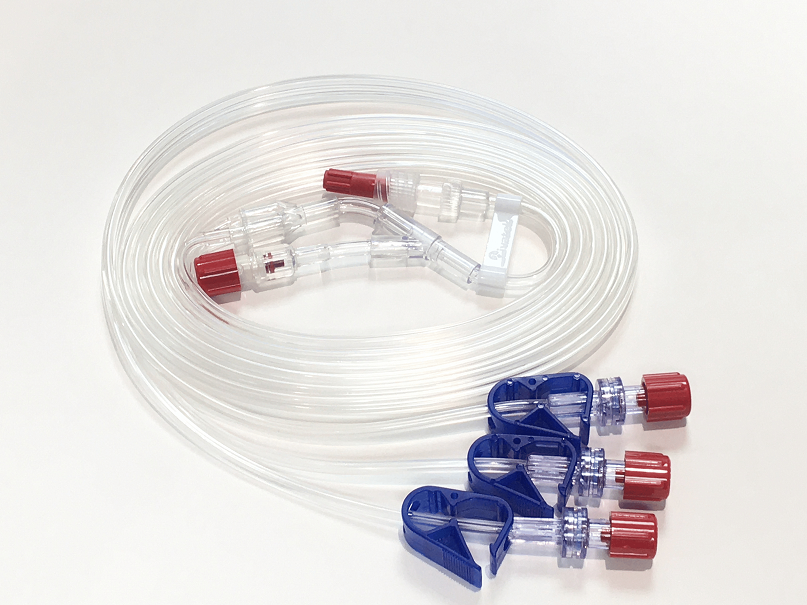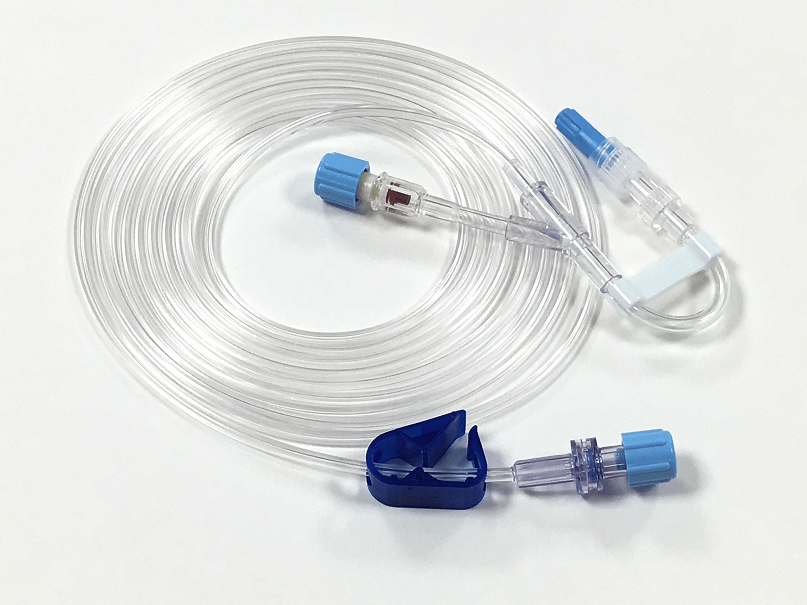Tivatek: Total Intravenous Anaesthesia (TIVA) sets
Absolute focus on creating a gold standard in Total Intravenous Anaesthesia (TIVA)
Total intravenous anaesthesia (TIVA) is a technique of general anaesthesia which uses a combination of agents given exclusively by the intravenous route without the use of inhalation agents (Gas Anaesthesia)[1].
There is a solid rationale for the use of TIVA in some patient cases where the delivery of inhaled anaesthetics is impossible or disadvantageous, or in scenarios where traditional anaesthetic delivery systems may be unavailable or impractical. In other cases, the use of TIVA could make the process more efficient and advantageous for the patient.
Compared generally to traditional volatile anaesthetic techniques, TIVA offers several potential advantages. These include reduced incidence of post-operative nausea and vomiting, reduced atmospheric pollution, more predictable and rapid recovery, greater haemodynamic stability, preservation of hypoxic pulmonary vasoconstriction, reduction in intracerebral pressure and reduced risk of organ toxicity.
In comparison to traditional inhalation anaesthesia, the inherent benefits of TIVA via a Target Controlled Infusion (TCI) make it a more straightforward and user-friendly technique for the caregiver, while at the same time offering a faster and more comfortable patient recovery[2].


Guidelines for the safe practice of total intravenous anaesthesia (TIVA)
Surveys of anaesthetists working in the UK and Ireland have concluded that training in TIVA is currently inconsistent. The 5th National Audit Project (NAP5) on accidental awareness during general anaesthesia found that self-reported cases of awareness were more common when TIVA was used, but that most of the cases were preventable and that the commonest contributory factor was inadequate education and training [3]. The report recommended that ‘the relevant anaesthetic organisations should establish a set of standards and recommendations for best practice in the use of TIVA’. These guidelines have been produced by the Society for Intravenous Anaesthesia (SIVA) and the Association of Anaesthetists in response to that recommendation.
The guidelines recommend that: The infusion set through which TIVA is delivered should have a Luer-lock connector at each end, an antisyphon valve on the drug delivery line(s) and an anti-reflux valve on any fluid administration line. Drug and fluid lines should join as close to the patient as possible to minimise dead space. All Tivatek sets include a high flow, one-way Codan valve on the wide bore gravity line. All valves are tested for failures and leaks and have a clinical dead space of 0.68ml.

The Safe Anaesthesia Liaison Group (SALG)
The Safe Anaesthesia Liaison Group (SALG) is a collaborative project between the Association of Anaesthetists, Royal College of Anaesthetists and NHS England/ NHS Improvement patient safety team. The group was formed in 2008 with the specific aim of reviewing and analysing, where possible, anaesthesia related serious incidents reported to the National Reporting and Learning System. Incidents with significant learning points are reported back to the anaesthesia community through a variety of communication methods. In addition, SALG provides regular updates on safety issues arising from incident review or from reports sent directly to SALG.
Guaranteeing drug delivery in Total Intravenous Anaesthesia (TIVA)
Based on a report produced by The Safe Anaesthesia Liaison Group (SALG) [4], Tivatek follows recommendations for guaranteeing the safe delivery of intravenous anaesthesia:
- Using a one-way valve on the intravenous line
It is suggested a one-way valve is used on the I.V. fluid port when multi-lumen I.V. connectors are used. All Tivatek sets include a high flow, one-way valve on the wide bore gravity line. All valves are tested for failures and leaks. - The site of the cannula must be monitored throughout the procedure
Disconnection of the Infusion or displacement of the cannula can go unnoticed, cannula sites should be visually checked at regular intervals as a practical and simple risk reduction. - Using Medical Equipment
When using medical equipment, it is essential clinical staff know all uses and limitations. A comprehensive IFU (instructions for use) is dispatched with all Tivatek equipment. - Organisations should ensure all one-way valves purchased are clearly labelled
Clear and informative packaging will aid correct selection of the appropriate system required for TIVA administration. Tivatek sets are delivered as a complete, sterile kit so there is no need to purchase an additional one-way valve or multi-lumen/y connector. This ensures all appropriate and necessary equipment is set up, ready for use. All products are labelled clearly for intended use.
References:
- ‘Total Intravenous Anesthesia using a target controlled infusion – A pocket reference’, College of Anesthesiologists, Academy of Medicine Malaysia (retrieved 07.10.15).
- Ozkose, Z., Ercan, B., Ünal, Y., Yardim, S., Kaymaz, M., Dogulu, F., & Pasaoglu, A. (2001). Inhalation versus total intravenous anesthesia for lumbar disc herniation: comparison of hemodynamic effects, recovery characteristics, and cost. Journal of neurosurgical anesthesiology, 13(4), 296-302.
- Pandit JJ, Andrade J, Bogod DG, et al. The 5th National Audit Project (NAP5) on accidental awareness during general anaesthesia: summary of main findings and risk factors. Anaesthesia 2014; 69: 1089–101.
- ‘Guaranteeing Drug Delivery in Total Intravenous Anaesthesia’, Safe Anaesthesia Liaison Group, 2009
Want to find out more?
If you would like to find out more information about Tivatek, please contact us on:
Tel: +44(0)1621 773471
Email: sales@europlaz.co.uk
Alternatively, you can complete the Contact Form on the Contact Us page.
Product features to support/optimise safe TIVA practice
The NHS released recommendations for product features to support/optimise safe TIVA practice, the chart below shows how Europlaz’s TIVA sets meet all recommendations.
| Requirement: | Do Europlaz’s TIVA sets meet this requirement? |
|---|---|
| Products may be available in a variety of internal diameters. The internal diameter must be stated on individual product packaging and /or UOI packaging and/or IFU and/or data sheet. | Yes |
| Priming volume must be stated on the individual product packaging and/or UOI packaging and/or IFU and/or data sheet. | Yes |
| Tubing must be made of flexible material, which is transparent or sufficiently transclucent that the interface of air and fluid during the passage of air bubbles can be observed with normal or corrected vision. | Yes |
| Where there is an anti-reflux/backcheck valve this must be stated on individual product packaging and/or UOI packaging and/or IFU. | Yes |
| In order to identify low sorbing materials, material type in the fluid pathway must be stated in individual product packaging and/or within the UOI and/or made available to the end user on request. | Yes |
| Products must be available in a variety of lengths. Length of the product must be stated on the individual product packaging. | Yes |
| PSI (pounds per square inch) must be stated on individual product packaging and/or UOI packaging and/or IFU and/or data sheet. | Yes |
| Product can be with or without clamp. Where clamp is present it must restrict flow and flow must resume after opening the clamp. | Yes |
| All connections must seal to prevent leakage along the line/s. | Yes |
| The distal end /patient end must be a male luer lock connection. | Yes |
| The proximal end/fluid end must be female luer lock connection/s. | Yes |
| The luer end must have a cap. | Yes |
| Tubing must be flexible and kink resistant. | Yes |
Want to find out more?
If you would like to find out more information about Tivatek, please contact us on:
Tel: +44(0)1621 773471
Email: sales@europlaz.co.uk
Alternatively, you can complete the Contact Form on the Contact Us page.
